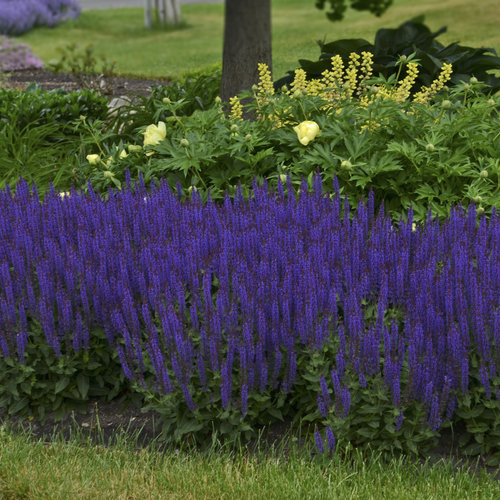 COLOR SPIRES® ‘Violet Riot’ Perennial Salvia (Salvia) COLOR SPIRES® ‘Violet Riot’ Perennial Salvia (Salvia)
Salvias of all kinds are highly attractive to bees, so expect to hear the consistent humm of these happy pollinators when yours are in bloom. They will be completely consumed with gathering pollen and won’t even look your way when you pass by. Expect to see butterflies and hummingbirds, too, but not deer since they don’t like salvia’s scented foliage. ‘Violet Riot’ salvia blooms prolifically with plump wands of vivid violet blue flowers from late spring to early summer. Find more colors in this series here.
Perennial in zones 3-8. Height: 22”. Full sun. Average to somewhat dry soil. |
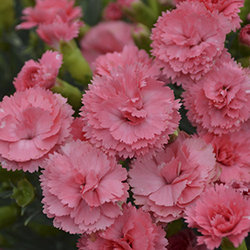 FRUIT PUNCH® ‘Classic Coral’ Pinks (Dianthus) FRUIT PUNCH® ‘Classic Coral’ Pinks (Dianthus)
One way to support native bees that forage near the ground is to grow ‘Classic Coral’. Its foliage hugs the ground in a low mound while wiry stems carry bouquets of dreamy coral pink, sweetly fragrant, double flowers in late spring. If you trim the spent flower stalks off when they are all done blooming, you’ll likely see another round of flowers in early fall. Butterflies also feed on this pretty perennial. Deer typically don’t bother to bend so far down to take a bite but rabbits will, so use a repellent if they become an issue in your garden. Find more colors in this series here.
Perennial in zones 4-9. Height: 8-10”. Full sun to part sun. Average to somewhat dry soil. |
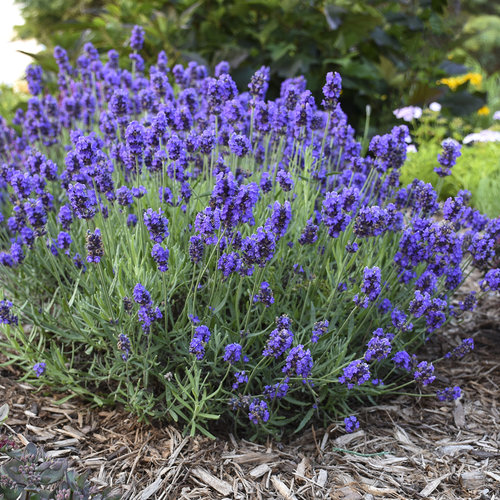 Sweet Romance® Lavender (Lavandula) Sweet Romance® Lavender (Lavandula)
Bees and butterflies enjoy lavender for many of the same reasons they enjoy salvia. This ornamental herb bears bright violet purple flowers—a color that is easy for bees to spot. Its signature sweet fragrance plays a role in attracting pollinators, too. New flowers pop up all summer long, so there will be plenty for enjoying in the garden and in fresh picked bouquets. Sweet Romance is a petite lavender that fits perfectly in containers and can be used as a colorful edging for flower beds.
Perennial in zones 5-9. Height: 12-18”. Full sun. Average to dry soil. |
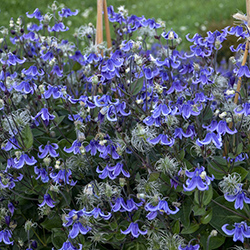 ‘Stand by Me’ Bush Clematis (Clematis) ‘Stand by Me’ Bush Clematis (Clematis)
You may have grown vining clematis before, but this selection grows more like a perennial. You may still want to give it some support from a cage or neighboring plants, but its stems grow upright to form a bushy clump. Bright blue, bell-shaped flowers appear on nodding stems in late spring to early summer followed by silky cream seed heads. If you’re lucky, you’ll see a few more flowers in late summer, too. Butterflies and hummingbirds have no problem dipping their long tongues into the heart of the pendulous flowers to drink their sweet nectar.
Perennial in zones 3-7. Height: 3’. Full sun to part sun. Average, alkaline soil. |
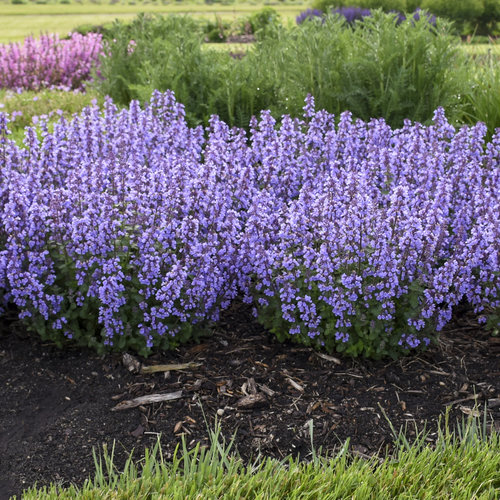 ‘Cat’s Pajamas’ Catmint (Nepeta) ‘Cat’s Pajamas’ Catmint (Nepeta)
This best-selling, floriferous perennial is as popular with gardeners as it is with bees, butterflies and hummingbirds. It blooms a couple of weeks earlier than most catmints, which means you’ll have flowers for pollinators beginning in late spring. Give the plant a quick shearing after the first round of bloom and it will reward you with more blooms until fall. This petite catmint is useful to plant around vegetable gardens to attract pollinators and thereby increase your yield. It is both deer and rabbit resistant. Looking for a taller catmint? Try ‘Cat’s Meow’.
Perennial in zones 3-8. Height: 12-14”. Full sun. Average to dry soil. |
| 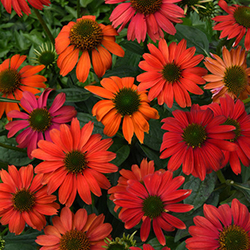 Summersong™ Firefinch™ Coneflower (Echinacea) Summersong™ Firefinch™ Coneflower (Echinacea)
Cultivars of our native coneflowers are a mainstay in sunny perennial borders where they bloom for months beginning in early to midsummer. You’ll see all kinds of bees, butterflies and songbirds enjoying this perennial’s blossoms. Large, copper cones provide the perfect landing pads for pollinators coming for a snack or just for a rest. This new variety produces a striking array of hot colored flowers ranging from red to orange to magenta. Its smaller size makes it suitable for containers or near the front of the border. Deer typically leave coneflowers alone but they are a favorite of rabbits, so use a repellent if they become an issue in your garden.
Perennial in zones 4-8. Height: 12-16”. Full sun to part sun. Average to somewhat dry soil. |
 ‘Serendipity’ Ornamental Onion (Allium). ‘Serendipity’ Ornamental Onion (Allium).
It is rare to walk by ‘Serendipity’ ornamental onion in bloom on a sunny summer day and not find several pollinating bees, butterflies or moths enjoying its nectar. This plant is an absolute pollinator magnet! Its cheerful rosy purple flowers stand like a bouquet of lollipops in the center of the blue-green foliage beginning in midsummer. They add whimsy to cut flower arrangements. Since this is an ornamental herb with onion-scented foliage, deer and rabbits typically steer clear.
Perennial in zones 4-8. Height: 15-20”. Full sun to part sun. Any well-drained soil will do. |
| 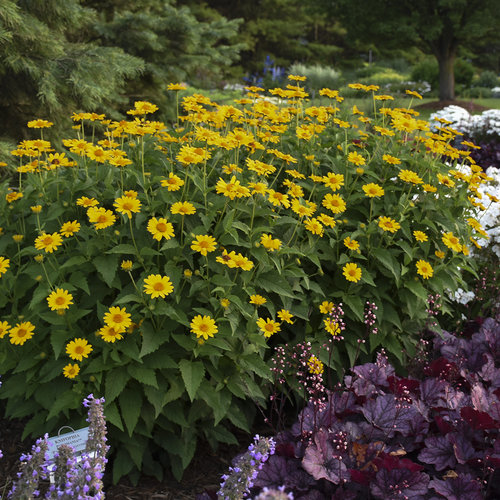 ‘Tuscan Sun’ False Sunflower (Heliopsis) ‘Tuscan Sun’ False Sunflower (Heliopsis)
Bring life to any dull space in your sunny landscape with this glowing yellow perennial. Its daisy-like blossoms make the perfect perch for butterflies and songbirds which come in for a landing around midsummer to late summer. This cultivar has native roots; the species can be found growing in the wild throughout central and eastern North America. It thrives in heavy soils, including clay, and prefers consistent moisture but will tolerate occasional periods of dryness once it is established. Be sure to plant more than one so you’ll have plenty of flowers to cut for fresh bouquets. If you like this plant, you might also like its cousin Tuscan Gold™.
Perennial in zones 3-9. Height: 24-36”. Full sun to light shade. Average to moist soil. |
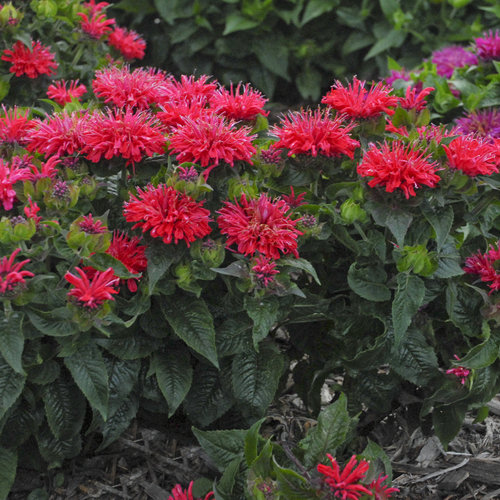 ‘Pardon My Cerise’ Bee Balm (Monarda) ‘Pardon My Cerise’ Bee Balm (Monarda)
You guessed it! Bee balm is attractive to bees, but you'll find that butterflies and hummingbirds often get in on the action, too. Its tubular florets are the perfect shape for them to dive in for a drink when the flowers start to open in midsummer. Tall bee balm varieties can be runners in the landscape, but the more petite Pardon My series includes all compact, mounded plants that stay where you plant them. They have strong resistance to powdery mildew and are deer resistant, so there’s no worry about planting a whole bunch of these pollinator favorites.
Perennial in zones 4-8. Height: 14-18”. Full sun to part sun. Average to moist soil. |
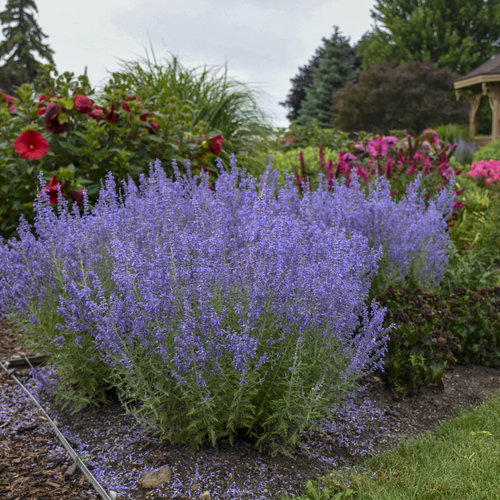 ‘Denim ‘n Lace’ Russian Sage (Perovskia) ‘Denim ‘n Lace’ Russian Sage (Perovskia)
In order to have something in bloom all season, make sure to plant a few perennials that flower later. They will keep pollinators well-fed before they make their migration southward. Russian sage starts to show color in midsummer but continues into fall, providing bees and hummingbirds with sustenance for several months. We like ‘Denim ‘n Lace’ because it blooms so prolifically on bushy, upright plants that won’t flop over onto other plants in the garden. It has great drought tolerance, too.
Perennial in zones 4-9. Height: 28-32”. Full sun. Average to dry soil |




 COLOR SPIRES® ‘Violet Riot’ Perennial Salvia (Salvia)
COLOR SPIRES® ‘Violet Riot’ Perennial Salvia (Salvia) FRUIT PUNCH® ‘Classic Coral’ Pinks (Dianthus)
FRUIT PUNCH® ‘Classic Coral’ Pinks (Dianthus) Sweet Romance® Lavender (Lavandula)
Sweet Romance® Lavender (Lavandula) ‘Stand by Me’ Bush Clematis (Clematis)
‘Stand by Me’ Bush Clematis (Clematis) ‘Cat’s Pajamas’ Catmint (Nepeta)
‘Cat’s Pajamas’ Catmint (Nepeta) Summersong™ Firefinch™ Coneflower (Echinacea)
Summersong™ Firefinch™ Coneflower (Echinacea) ‘Serendipity’ Ornamental Onion (Allium)
‘Serendipity’ Ornamental Onion (Allium)
 ‘Pardon My Cerise’ Bee Balm (Monarda)
‘Pardon My Cerise’ Bee Balm (Monarda) ‘Denim ‘n Lace’ Russian Sage (Perovskia)
‘Denim ‘n Lace’ Russian Sage (Perovskia)
